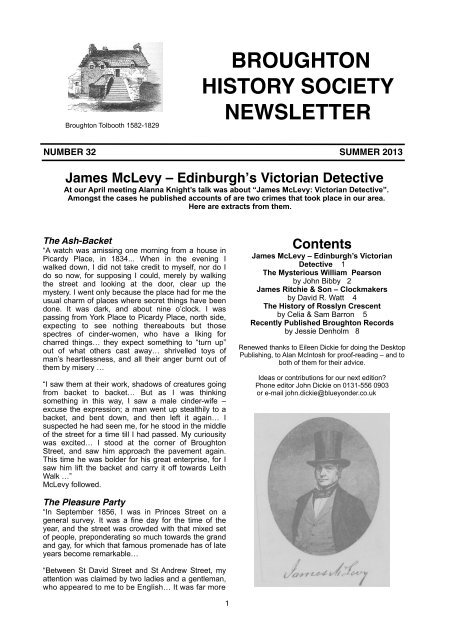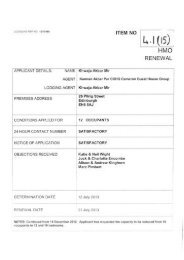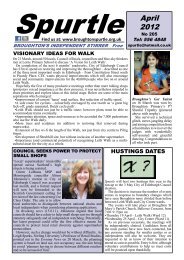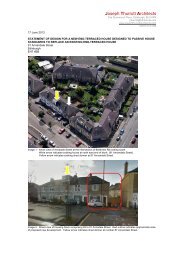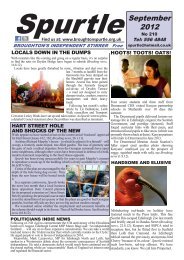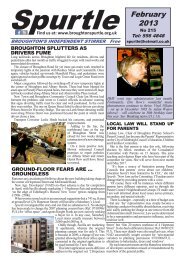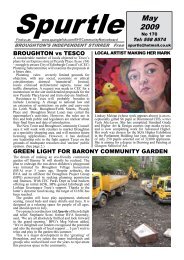BROUGHTON HISTORY SOCIETY NEWSLETTER - Broughton Spurtle
BROUGHTON HISTORY SOCIETY NEWSLETTER - Broughton Spurtle
BROUGHTON HISTORY SOCIETY NEWSLETTER - Broughton Spurtle
Create successful ePaper yourself
Turn your PDF publications into a flip-book with our unique Google optimized e-Paper software.
<strong>Broughton</strong> Tolbooth 1582-1829<br />
<strong>BROUGHTON</strong><br />
<strong>HISTORY</strong> <strong>SOCIETY</strong><br />
<strong>NEWSLETTER</strong><br />
NUMBER 32 ! ! ! ! ! ! ! ! ! SUMMER 2013<br />
! James McLevy – Edinburghʼs Victorian Detective<br />
At our April meeting Alanna Knight’s talk was about “James McLevy: Victorian Detective”.<br />
Amongst the cases he published accounts of are two crimes that took place in our area.<br />
Here are extracts from them.<br />
The Ash-Backet<br />
“A watch was amissing one morning from a house in<br />
Picardy Place, in 1834... When in the evening I<br />
walked down, I did not take credit to myself, nor do I<br />
do so now, for supposing I could, merely by walking<br />
the street and looking at the door, clear up the<br />
mystery. I went only because the place had for me the<br />
usual charm of places where secret things have been<br />
done. It was dark, and about nine o’clock. I was<br />
passing from York Place to Picardy Place, north side,<br />
expecting to see nothing thereabouts but those<br />
spectres of cinder-women, who have a liking for<br />
charred things… they expect something to “turn up”<br />
out of what others cast away… shrivelled toys of<br />
man’s heartlessness, and all their anger burnt out of<br />
them by misery …<br />
“I saw them at their work, shadows of creatures going<br />
from backet to backet… But as I was thinking<br />
something in this way, I saw a male cinder-wife –<br />
excuse the expression; a man went up stealthily to a<br />
backet, and bent down, and then left it again… I<br />
suspected he had seen me, for he stood in the middle<br />
of the street for a time till I had passed. My curiousity<br />
was excited… I stood at the corner of <strong>Broughton</strong><br />
Street, and saw him approach the pavement again.<br />
This time he was bolder for his great enterprise, for I<br />
saw him lift the backet and carry it off towards Leith<br />
Walk …”<br />
McLevy followed.<br />
Contents<br />
James McLevy – Edinburgh’s Victorian<br />
Detective 1<br />
The Mysterious William Pearson<br />
by John Bibby 2<br />
James Ritchie & Son – Clockmakers<br />
by David R. Watt 4<br />
The History of Rosslyn Crescent<br />
by Celia & Sam Barron 5<br />
Recently Published <strong>Broughton</strong> Records<br />
by Jessie Denholm 8<br />
Renewed thanks to Eileen Dickie for doing the Desktop<br />
Publishing, to Alan McIntosh for proof-reading – and to<br />
both of them for their advice.<br />
Ideas or contributions for our next edition?<br />
Phone editor John Dickie on 0131-556 0903<br />
or e-mail john.dickie@blueyonder.co.uk<br />
The Pleasure Party<br />
“In September 1856, I was in Princes Street on a<br />
general survey. It was a fine day for the time of the<br />
year, and the street was crowded with that mixed set<br />
of people, preponderating so much towards the grand<br />
and gay, for which that famous promenade has of late<br />
years become remarkable…<br />
“Between St David Street and St Andrew Street, my<br />
attention was claimed by two ladies and a gentleman,<br />
who appeared to me to be English… It was far more<br />
1
easy for me to mark them than to give you<br />
reasons why they had an interest for me. What<br />
though I were to say that they appeared a degree<br />
too curious about the dresses of the ladypromenaders…<br />
they all three went tripping gaily<br />
up St Andrew Street, at the top of the northern<br />
division of which they met a very little dapper<br />
dandy, not over five feet and an inch or two…<br />
“At length he, who, though small, seemed to be<br />
leader, pointed north, drawing out the while a<br />
watch, and they appeared decided, all setting off<br />
along St Andrew Square. I immediately<br />
concluded they were for Scotland Street station,<br />
for I knew the northern train went about the time,<br />
and there is there often a conveniently crowded<br />
platform.<br />
“My conjecture was right. The party made direct<br />
for Scotland Street… they never hesitated or<br />
stopped till they got to the top of the stair leading<br />
to the station-house. Being so utterly unknown to<br />
our English friends, there was no necessity for my<br />
usual caution; and accordingly, the moment they<br />
disappeared, Riley and I went forward to the<br />
parapet overlooking the station and platform, and<br />
placing our elbows upon it, put ourselves in the<br />
position of lounging onlookers… A crowd of people<br />
were there, among whom a number of likely ladies,<br />
with pockets far better filled than those of mere<br />
promenaders in Princes Street… Then came the<br />
rumble of the train down the tunnel, at the sound of<br />
which the passengers began to move, carrying their<br />
The tunnel is on the right. In McLevy’s day the platform was<br />
where the play equipment is now, and steps down to the<br />
station from the street where the grass and trees are.<br />
luggage to the edge of the platform, and all on the<br />
tiptoe of expectation. But now I fairly admit that I<br />
never more regretted so much the want of half-adozen<br />
eyes. The nimble artistes were all at work at<br />
the same time – they were, in short, in a hurry of<br />
pocket-picking...<br />
Sources: “The Pleasure Party” is in McLevy the<br />
Edinburgh Detective (Mercat Press, Edinburgh, 2001),<br />
and “The Ash-Backet” in McLevy Returns (Mercat Press,<br />
Edinburgh, 2002).<br />
Our original article is in Newsletter 26, Wiinter 2009<br />
The Mysterious William Pearson<br />
! ! ! ! ! ! Reader John Bibby explains<br />
I am researching the family of Karl Pearson<br />
(1857-1936), the “founder of modern statistics”. His<br />
father William (1822-1907) spent the years<br />
1841-1848 in Edinburgh, but little is known about<br />
this undoubtedly formative period in his life. He<br />
arrived [from Yorkshire] mysteriously; he departed<br />
mysteriously; and the next two known events are<br />
that (a) he had an illegitimate child in London in<br />
1849, and (b) he then became an eminent and<br />
extremely upright barrister for the rest of his life.<br />
This short article relates to William Pearson’s time<br />
in Edinburgh. It has lots of loose ends and I would<br />
welcome assistance from anyone knowledgeable<br />
about this place at that time. You can email me at<br />
jb43@york.ac.uk<br />
Whatever his reason for leaving Yorkshire, the next<br />
record of young William occurs in the Scottish<br />
census of June 1841. William, aged 18, is “Writer,<br />
Lodger” in <strong>Broughton</strong> Street. (“Writer” presumably<br />
has a legal connotation – perhaps a solicitor’s<br />
clerk? It would be good to know which solicitor he<br />
was with.) William was in the census household of<br />
Jane Grant, a 40-year-old “druggist”, whose<br />
husband Alexander is described elsewhere as<br />
“druggist, surgeon, and accoucheur” (midwife). The<br />
household consisted solely of Jane, William, and<br />
Margaret O’Conner, a 20-year-old “F.S.” (female<br />
2<br />
servant) born in Ireland. (Alexander was not there.)<br />
The Grant household was exceptional for<br />
<strong>Broughton</strong> Street in that its members were all born<br />
outside Scotland. The only other such household<br />
nearby was that of William Doherty, a 25-year old<br />
physician, who with his wife and F.S. were all Irishborn.<br />
The houses on <strong>Broughton</strong> Street were not<br />
numbered in the census. However, Pigot’s 1837<br />
directory lists “Alexander Grant, surgeon and<br />
druggist” at 15 <strong>Broughton</strong> Street, so we may<br />
assume that this was where young William was<br />
staying.<br />
William is said to have obtained an Edinburgh<br />
LL.D. However, that along with other aspects of his<br />
recorded history appears to be false – the only<br />
Edinburgh LL.D.s in those days were honorary.<br />
What is true, however, is that in 1844 William<br />
began attending Law classes at the University of<br />
Edinburgh. We do not know what led him to study<br />
Law: he seems to have been the first in his family<br />
to do so. But he was not the last – even today<br />
there are firms of solicitors around York with<br />
“Pearson” in their title: these date back to William’s<br />
brother Robert. William won several class prizes:<br />
“Prizeman in Roman Civil Law, 1845; in Scots Law,<br />
1847; Gold Medallist, Edinburgh University, 1847”.
(This is according to “Who’s Who 1900”, where<br />
William and his illustrious son Karl both have<br />
entries – no doubt self-written some half-century<br />
after the events.)<br />
However, after three years of apparent success in<br />
Edinburgh, something seems to have gone<br />
seriously wrong with William, for his records<br />
terminate abruptly with an enigmatic note in the<br />
Pearson Archives hand-written by the extremely<br />
deaf Professor Allan Menzies: “I certify that Mr<br />
Pearson attended with perfect regularity until 28<br />
January 1848, when he left Edinburgh, & that in all<br />
the Examinations he was highly distinguished by<br />
the extent and accuracy of his knowledge”.<br />
William Pearson’s student card, November 1844<br />
One can only speculate what triggered this sudden<br />
departure. Was there a crisis of some sort – a<br />
scandal perhaps? Was his rapid departure from<br />
Edinburgh perhaps linked to the illegitimacy which<br />
has already been referred to, or to some other<br />
liaison? Answers to these questions are unknown.<br />
However, from 1850 William appears to have<br />
entered a life of complete Victorian uprightness and<br />
respectability.<br />
Editor: Nos 1-17 <strong>Broughton</strong> Street faced St Mary’s Cathedral but disappeared in the 1960s when the<br />
triangle at the top of the street was demolished. The photo shows that this was the first side of the<br />
triangle to go.<br />
We found the photo in “In the end the beginning: an account of St. Mary’s Cathedral Edinburgh<br />
1814-1964 by J.A.S.Shaw, attributed to the Scotsman but undated.<br />
3
James Ritchie & Son – Clockmakers<br />
Bellevue Place resident David Watt has previously contributed several articles to our Newsletter,<br />
including one back in 2001 about Ritchies the clockmakers. Now David has given us more details to<br />
fill out the original article – including his own Ritchie connection.<br />
In the Edinburgh Evening Courant newspaper of<br />
7th January 1805 it was announced that James<br />
Ritchie, watchmaker in Edinburgh, had married<br />
Sally Neill in late December. In 1809 he established<br />
himself as a clockmaker at 29 Leith Street; and in<br />
1819 took over the neighbouring business of<br />
Joseph Durward (established in 1775). James and<br />
his wife lived in North St James Place and later<br />
moved to 27 St James Square (now part of the<br />
Register House complex) where their title deeds<br />
allowed them to dry their washing on the green at<br />
Moultries Hill. The firm now started to deal in<br />
jewellery and pocket watches as well as clocks –<br />
the first watch they sold in 1819, a massive turnip<br />
watch with only an hour hand, was sold back to<br />
them in 1933.<br />
By 1836 the firm had moved to 25 Leith Street and<br />
changed its name to James Ritchie & Son. The<br />
premises comprised a shop at street level and 3<br />
basement flats under which were the workshops for<br />
over 100 years. These exited onto St Ninian’s Row.<br />
One son was sent to Paris to learn clockmaking,<br />
got in with some medical students and became a<br />
doctor in England. Another son, Frederick James<br />
Ritchie (1828-1906), was to be the driving force<br />
behind the firm for most of the 19th century.<br />
The firm was awarded the prestigious Reid-Auld<br />
prize for innovations in clock design. History<br />
Society members who attended the recent visit to<br />
the City Observatory [in 2001] will recall the part<br />
played by the firm, under Frederick’s leadership, in<br />
the installation of the timeball and gun in 1861. The<br />
idea was not new and was in fact a copy of a<br />
system used in Paris where they fired the gun at 12<br />
noon. It has been said that the canny Scots<br />
decided to fire the Edinburgh gun at 1pm to save<br />
11 rounds of ammunition!<br />
Frederick II, son of Frederick James took over the<br />
management of the business when his father<br />
retired. Unfortunately Frederick II had social<br />
ambitions beyond his means... he sold stock and<br />
used the money for his own ends... the firm was<br />
heavily overdrawn at the bank. His youngest<br />
brother Leone (family name Leo) was forced to<br />
surrender his house in Joppa as security to the<br />
bank. He was a quiet diffident man, seeking only to<br />
tend clocks. It was never intended that he should<br />
ever have control of the family business and when<br />
it was thrust upon him when his brother Frederick<br />
was bought out he was not equipped for the job.<br />
Whenever problems arose at work he suffered from<br />
an upset stomach.<br />
In the mid 1840s James Ritchie was asked to fit a<br />
lightning conductor to the Scott Monument. The<br />
work was not finished by Saturday afternoon. While<br />
James was attending church on the following day a<br />
violent electrical storm hit Edinburgh and James<br />
had to change the direction of his prayers for his<br />
own salvation to that of the Scott Monument; they<br />
worked!<br />
The mechanical side of clockmaking gave way to<br />
the increasing use of electricity and the Ritchies<br />
were leaders in this new field. Alex Bain – a genius<br />
who started life as a sheperd in Caithness, invented<br />
the first electric clock and the principles of<br />
telegraphy and faxing machines – and Alexander<br />
Graham Bell, inventor of the telephone, were<br />
among the Ritchies’ friends.<br />
Frederick Ritchie succeeded on his father’s death in<br />
1849. In 1856 he married Annie Wallace Rose, a<br />
member of a shipping family in Leith; they spent<br />
their first two years living in Hart Street before<br />
moving with the first of their children to 33 London<br />
Street. Her brother Lachlan was in business as a<br />
ship’s chandler at 81 Mitchell Street and he it was<br />
who produced the well-known Rose’s Lime Juice. In<br />
1869 they moved again, to 6 Brunton Place –<br />
which remained the family home until the last of the<br />
spinster Ritchie sisters died in 1960.<br />
4
Meanwhile, he had married Mary Sim Hill in 1897.<br />
Their first house was at 25 Dalgety Street,<br />
Edinburgh where on 12th November 1898 the<br />
present writer’s mother Catherine Richardson<br />
Ritchie was born (her family name became Cassie).<br />
We next find the young Ritchies moving to 77<br />
McDonald Road; Catherine and her two younger<br />
sisters all started their education at <strong>Broughton</strong><br />
School a few hundred yards north of their home.<br />
She took after her father in character: shy, diffident,<br />
yet holding firmly to her carefully thought out<br />
beliefs. She was a bright scholar, particularly in<br />
essay writing. She had intended to be a school<br />
teacher but her voice was not strong enough<br />
for this profession so she became assistant<br />
secretary to the Queen’s Club in Frederick Street.<br />
In 1919 she met David Watt, newly home from the<br />
First World War. Their first meeting was in the social<br />
guild of the United Free Presbyterian Church in<br />
Portobello. It was seven years after they met before<br />
they were able to get married, on 10th July 1926. In<br />
those days married women did not work so she<br />
resigned on her marriage. They were chronically<br />
hard up – this was the period of the Great<br />
Depression. And soon they had the additional<br />
expense of their son, David Ritchie Watt, born on<br />
Friday 13th May 1927!<br />
Though the First World War took its toll on<br />
members of staff it was not until the depression of<br />
1930 and following staff dishonesty that the firm<br />
had to close the Princes Street branch. In the<br />
Second World War the younger staff members were<br />
called up and most of the skilled watch and clockmakers<br />
were lost to the new Ferranti factory. The<br />
firm were still pioneers – in the late 1940s when<br />
King George VI was being treated for vein trouble in<br />
his legs by Edinburgh University’s Professor<br />
Learmonth, the firm designed and made a machine<br />
to alleviate the trouble.<br />
In 1953 the sole remaining partner Leone Ritchie,<br />
then in his 80s, retired and the Leith Street<br />
premises were sold. The firm was taken over by his<br />
nephew, Robert<br />
Mitchell, and<br />
based in Little<br />
K i n g S t r e e t<br />
before settling<br />
in 56 <strong>Broughton</strong><br />
Street. After Mr<br />
Mitchell’s death<br />
the business<br />
left the family.<br />
It was bought<br />
by Mr Frank<br />
Pritchard, who<br />
had served his<br />
apprenticeship<br />
with the Ritchies.<br />
Under his leadership the business prospered, an<br />
associated firm of precision engineering being<br />
established in Livingston.<br />
James Ritchie & Son (Clockmakers) Ltd have two<br />
logos. One depicts Edinburgh Castle and Nelson’s<br />
Column with the time ball (previous page). The<br />
other has a picture of a young girl standing on a<br />
chair to alter the hands of a grandfather clock. This<br />
girl, Catherine Ritchie, was later to be my mother.<br />
Editor: The firm recently moved away from <strong>Broughton</strong><br />
Street and is now in Dundas Street – “James Ritchie &<br />
Son (Clockmakers) Ltd. Retail and Repairs”.<br />
Sources:<br />
Watt, David Ritchie (2001 )James Ritchie & Son<br />
(Clockmakers) Ltd., <strong>Broughton</strong> History Society<br />
Newsletter No.9.<br />
Watt, David R. (Spring 2000) The Family Tree of David<br />
R. Watt, compiled at 21 Bellevue Place.<br />
Correspondence between David Watt and John Dickie.<br />
THE <strong>HISTORY</strong> OF ROSSLYN CRESCENT<br />
Neighbouring Pilrig also has an interesting history. Celia and Sam Barron are researching a<br />
particular part of it<br />
A number of years ago we were curious to find out<br />
who had lived in our house in Rosslyn Crescent<br />
since it was built in 1886. As it turned out we didn’t<br />
find any really interesting past tenants but we did<br />
begin to see that the broader history of Rosslyn<br />
Crescent, and the adjacent Rosslyn Terrace, was<br />
much more fascinating. Thus began our project to<br />
research the history of the Crescent and the<br />
Terrace.<br />
The detective work became really addictive. Initially<br />
we looked at the deeds of our own house then<br />
widened our search area to look at the Register of<br />
Sasines, Post Office directories, the Valuation roll,<br />
newspapers, the Edinburgh Gazette and many<br />
other sources of information.<br />
Research is still at a very early stage and as yet we<br />
have no idea what the final outcome will be. The<br />
5<br />
following is just a taste of what we have<br />
discovered so far.<br />
THE LANDS OF THE LAIRD OF PILRIG<br />
The land on which Rosslyn Crescent and Rosslyn<br />
Terrace were built belonged to John Mackintosh<br />
Balfour, the 4th Laird of Pilrig, who lived in Pilrig<br />
House. It was at the extreme edge of Edinburgh<br />
with the boundary between Edinburgh and Leith<br />
running up the middle of Pilrig Street. Johnston’s<br />
1837 map (Figure 1 overleaf) shows an area of<br />
open green space dotted with large houses such<br />
as Bowers Hall, Pilrig House, Stewartfield,<br />
Rosebank, Powderhall, Blandfield and Shrub<br />
House. The population of Edinburgh quadrupled<br />
between 1801 and 1901 resulting in an urgent<br />
need for housing, so landowners began to feu<br />
parcels of land for house building. Barbara<br />
Balfour, in her book on the history of the Balfour
Figure 1 Johnston 1837 Rosslyn Crescent would be built<br />
close to the ‘P’ in Pilrig Street<br />
family, recounts that her<br />
father John Mackintosh<br />
B a l f o u r b e c a m e<br />
increasingly concerned<br />
a t t h e n u m b e r o f<br />
t e n e m e n t b u i l d i n g s<br />
which were changing<br />
the appearance of the<br />
area. The feu charters<br />
for the Crescent and<br />
Te r r a c e w e r e v e r y<br />
restrictive, requiring all<br />
plans to be approved by<br />
Balfour. He was anxious<br />
t o e n c o u r a g e t h e<br />
building of “houses that<br />
well to do artisans could<br />
l o o k f o r w a r d t o<br />
p u r c h a s i n g ” . T h e<br />
Cockburn Association<br />
recently stated “there is<br />
no d o u b t t h a t t h e<br />
unlisted buildings of<br />
R o s s l y n Crescent/<br />
Terrace have a distinct<br />
character and that they<br />
have a wider value in<br />
u n d e r s t a n d i n g t h e<br />
historic expansion of<br />
Edinburgh”. This is the<br />
heritage of Balfour’s<br />
vision.<br />
HOW IT ALL BEGAN<br />
In the early 19th century<br />
there were plans for<br />
housing on both sides of<br />
Pilrig Street. Kirkwood’s<br />
map dated 1817 (Figure<br />
2) shows an ambitious<br />
grid development of<br />
t h r e e s t r e e t s – S t<br />
Cuthbert’s Street, Whyte<br />
Street (now Rosslyn<br />
Crescent) and Melville<br />
Figure 2 Kirkwood 1817 - Proposed development of Pilrig Street<br />
6<br />
Figure 3 Bartholemew’s Post Office Plan 1917-18
Street. The demise of this plan was fortunate as<br />
there would be no Pilrig Park if it had been<br />
completed. Bartholomew’s 1917 Post Office map<br />
shows the actual development (Figure 3) and<br />
includes details of an unfulfilled plan to extend<br />
Balfour Place through to Pilrig Street.<br />
Rosslyn Crescent and Rosslyn Terrace were built in<br />
six phases.<br />
Phase 1: 1870-71 6–12 Rosslyn Crescent<br />
In 1869 James Cowie, a builder at 38 Haddington<br />
Place, borrowed £1200 to build 1–4 Rosslyn Street<br />
(later renamed 6–12 Rosslyn Crescent). The street<br />
was originally to be called Whyte Street, but was<br />
renamed because Cowie was very fond of the<br />
Midlothian village of Roslin. These 4 cottage-style<br />
houses stood in open countryside, surrounded by<br />
nursery gardens belonging to the Pilrig estate.<br />
Although advertised for sale in the Scotsman on<br />
22nd January 1870, James Cowie retained<br />
ownership of all four houses for many years. The<br />
1871 census shows James, his wife Barbara, their<br />
7 children and his mother-in-law living in No 6,<br />
originally called Ivybank Cottage. A member of the<br />
Cowie family lived in there from 1870 to 1949.<br />
Initially the other three houses were rented but in<br />
July 1899 Cowie gave all four houses to his<br />
children William, Jemima, Elizabeth and Mary.<br />
Members of the Cowie family are buried in<br />
Rosebank Cemetery.<br />
Phase 2: 1875-76 3 Rosslyn Crescent and 5–9<br />
Rosslyn Terrace (formerly Hartington Terrace)<br />
In May 1875, John Mackintosh Balfour feued two<br />
parcels of land to architect David Clunas who then<br />
subfeued to Henry Harding, a bricklayer and<br />
furnace builder in St Stephen’s Street, and to<br />
architect Charles Sey. Originally the Terrace was<br />
planned to run through to Dryden Street, with<br />
houses on both sides. The houses were to be of not<br />
less than £700 value. Harding borrowed £1750 and<br />
built 3 Rosslyn Crescent and 5, 7 and 9 Rosslyn<br />
Terrace. Harding, Sey and Clunas went bankrupt<br />
soon after, so the grand plans for Rosslyn Terrance<br />
were never completed.<br />
Phase 3: 1876-77 1 Rosslyn Crescent<br />
John Mackintosh Balfour feued land at the junction<br />
of Rosslyn Street and Pilrig Street to Henry Harding<br />
to build two 2-storeyed houses on Pilrig Street with<br />
a third dwelling house above them to be entered<br />
from Rosslyn Street. The overall value should be at<br />
least £2000. The first of the two houses at the<br />
corner of Pilrig Street was sold in May 1877.<br />
Phase 4: 1881-1886 11–52 Rosslyn Crescent<br />
In October 1881, John Mackintosh Balfour feued<br />
land to William Baird, Alexander Drysdale and<br />
George Gilmour to form the new Rosslyn Crescent,<br />
with pleasure gardens in the middle.<br />
In Victorian times it was common for builders to buy<br />
small tranches of land on which they built and sold<br />
two or three houses at a time. As a result<br />
developments with an overall cohesive design were<br />
difficult to achieve as is evident from the mixture of<br />
house designs found in Pilrig Street. Rosslyn<br />
7<br />
Crescent, however, developed in a much more<br />
planned fashion. It was unusual for a small building<br />
company to be able to take on what was to be a<br />
five-year project. Baird, Drysdale and Gilmour<br />
arranged a number of different bonds with interest<br />
rates between 4 and 5% to be repaid within 15<br />
years. In total they borrowed £14,400, by today’s<br />
prices around £1.5 million. They built and sold a<br />
small group of houses at a time and discharged the<br />
loan before taking on a new one to build more<br />
houses. Building started in 1881 and was<br />
completed in 1886. Gilmour & Drysdale retained<br />
several houses for rental. In 1902, their partnership<br />
was dissolved and ownership passed to George<br />
Gilmour. Gilmour was later declared bankrupt in<br />
1911. In 1895, Rosslyn Street and Rosslyn<br />
Crescent were renamed Rosslyn Crescent and<br />
Hartington Terrace became Rosslyn Terrace, and<br />
all the houses were renumbered.<br />
The builders or their families all lived in the<br />
Crescent. Cowie lived in No 6 and Harding in No 3.<br />
Baird bought the house at the corner of Pilrig Street<br />
(now 1 Rosslyn Crescent) and also owned No 36<br />
from 1883 to 1888. George Gilmour lived in No 19<br />
from 1887 to 1909 when he moved to No15 to live<br />
with his daughter Helen Gilmour. She continued to<br />
live there until 1968. The 1901 census shows<br />
Drysdale, his wife Helen and their 7 children living<br />
in No 38 but he later moved to 70 Pilrig Street.<br />
Phase 5: 1934-1937 5,7 and 9 Rosslyn<br />
Crescent and 2, 11–27 Rosslyn Terrace<br />
The planned extension of Rosslyn Terrace through<br />
to Dryden Street was never completed. By the late<br />
1920s, the vacant land was managed by Edinburgh<br />
Corporation as allotments, but owned by Annie<br />
Davy and Vera Geddes, granddaughters of John<br />
Mackintosh Balfour. In 1934, the land was feued to<br />
Joseph Mellon, a builder from Goldenacre, to build<br />
4 apartments of a value of not less than £600 in<br />
Rosslyn Crescent and 9 houses valued at £750 in<br />
Rosslyn Terrace.<br />
Phase 6: 1986 4 Rosslyn Crescent<br />
The last site to be developed was 4 Rosslyn<br />
Crescent, on land which was previously the garden<br />
of the Balfour House Hotel, Pilrig Street.<br />
Figure 4 Bonfire night in Rosslyn Crescent<br />
by Frank Robbie
THE PLANNY<br />
An attractive feature of Rosslyn Crescent is the<br />
green area in the centre known as the Planny. The<br />
deeds of every house refer to the “pleasure<br />
gardens” which were surrounded by railings until<br />
removal in wartime. It is not known why it became<br />
known as the Plantation or Planny. Today the<br />
Planny is central to the highly regarded Rosslyn<br />
Crescent community spirit. The Planny is not just a<br />
place for children to play but also for social<br />
gatherings. Frank Dobbie, a resident for many<br />
years, captured the spirit of the Planny in his<br />
bonfire night painting (Figure 4).<br />
INTERESTING RESIDENTS<br />
As the research develops, information about the<br />
people who have lived in the street over the years<br />
is growing.<br />
Several residents were involved in army and navy<br />
service. Research by Jessie Denholm (a member of<br />
<strong>Broughton</strong> History Society) indicates that 10 young<br />
men from the Crescent served in the First World<br />
War. Charles Drover from No 21 was killed in action<br />
in 1918, aged 20. John Adam Tait, who lived in No<br />
20, served with the 16th Battalion Royal Scots and<br />
fell at the Battle of the Somme. The Scott family of<br />
No 52 had 5 sons all serving in the armed forces in<br />
the First World War. Frank Scott was awarded the<br />
Military Cross in 1917 while James Scott died from<br />
influenza in November 1918. William Johnstone<br />
from No 43 was the paymaster on HMS Russell<br />
which struck a mine on 27th April 1916. Johnstone<br />
survived and after a number of promotions in the<br />
Royal Navy eventually served in the Australian<br />
Navy. Kenneth and Alan McBean who lived in 9<br />
Rosslyn Terrace both died in action.<br />
,<br />
Leslie Alexander Massie, 31 Rosslyn Crescent, was<br />
a lieutenant with the Royal Scots Fusiliers in 1945.<br />
A solicitor by training, he eventually became<br />
President of the Supreme Court in Malaysia and<br />
was a judge during the Japanese War Trials. His<br />
wife Margot N. Massie donated a banner to St Giles<br />
Cathedral in memory of her husband.<br />
There were many maritime associations with the<br />
Crescent. In the late 1880s J. M. Clarke from No 30<br />
must have been proud of Rosslyn Crescent as he<br />
named a steam trawler he owned Rosslyn.<br />
Unfortunately in December 1893 the Rosslyn<br />
collided with the SS Bull in the Forth, causing the<br />
Bull to sink. A formal investigation found that the<br />
skipper of the Rosslyn was at fault but not its<br />
owner. Andrew Lamb,<br />
w h o o w n e d 3 4<br />
R o s s l y n C r e s c e n t<br />
between 1883 and<br />
1892, was an engineer<br />
on the SS Woosung,<br />
t r a d i n g i n C h i n a .<br />
Captain Alexander<br />
Wilson lived in No 9<br />
and was master of the<br />
SS Kirkland which<br />
during the Second<br />
World War transported<br />
petrol to Greece and<br />
the Western Desert,<br />
frequently coming<br />
under heavy air attack.<br />
I n 1 9 4 2 C a p t a i n<br />
Wilson was awarded<br />
an OBE for gallantry.<br />
Other residents of<br />
interest include the Rev. Gideon Jasper Richard<br />
Ouseley (Figure 5) who was a tenant in No 10, from<br />
1870 to ‘73. Born in Lisbon, Portugal, he studied at<br />
Dublin University and was an Anglican priest in<br />
Warrenpoint, N Ireland. He left the Anglican Church<br />
and joined the Catholic Apostolic Church. He may<br />
have been a priest at the church now the home of<br />
the Mansfield Traquair Centre.<br />
Current resident Margaret Kinghorn’s family links<br />
with the Crescent go back to 1919 and she, her<br />
parents, grandparents and great grandparents<br />
have lived in Nos 19, 30, 37 and 39.<br />
FUTURE RESEARCH<br />
The research is still at an early stage. There is a<br />
huge amount of material still to be trawled from a<br />
wide range of readily available databases. Personal<br />
recollections of those who have links with Rosslyn<br />
Crescent and Terrace are being sought. So far it<br />
has been difficult to find photographs of the<br />
Crescent pre the 1970s. Any information that would<br />
extend the study would be greatly appreciated.<br />
Celia & Sam Barron 0131 554 8610<br />
Figure 5 Rev. Gideon<br />
Jasper Richard Ouseley<br />
Recently Published <strong>Broughton</strong> Records<br />
Jessie Denholm reports<br />
The Scottish Genealogy Society has recently published two books of material transcribed from the records of the<br />
former <strong>Broughton</strong> Place Church. These are <strong>Broughton</strong> Place Associate Congregation, Edinburgh – Names of<br />
Members 1795 (ISBN 1-904060-98-6, price £2.50) and <strong>Broughton</strong> Place United Presbyterian Church, Edinburgh,<br />
Band of Hope Register 1886-1908 (ISBN 1-904060-96-X, price £3.00). This church went through a number of name<br />
changes during its existence – hence the different name.<br />
These books are not being recommended as a ‘good read’. They do, however, contain material which any historian of<br />
the<strong>Broughton</strong> area might find useful. Basically what they contain is lists of names and addresses. I have found the<br />
Band of Hope Register useful in connection with the First World War Project – some of the boys who joined the Band<br />
of Hope (a temperance organisation for children) also feature on local war memorials. I could envisage them being<br />
useful for a study of a particular street or indeed of <strong>Broughton</strong> Place Church itself. They can be bought online from<br />
www.scotsgenealogy.com or by calling at the Scottish Genealogy Society’s Library at 15 Victoria Terrace, Edinburgh.<br />
(I am normally there on Thursday afternoons and I would be delighted to show <strong>Broughton</strong> History Society members<br />
the facilities available there for research into local as well as family history – Jessie Denholm 0131 552 7598)<br />
Back issues of the Newsletter are available on the Society’s page at www.broughtonspurtle.org.uk<br />
8


